How Carnoustie prepared for this year’s Open
Related Articles
Carnoustie is known as ‘Golf’s Greatest Test’, but it also proved to be demanding for the greenkeeping team to host this year’s Open Championship amid sweltering conditions. GreenKeeping speaks to its links superintendent, Sandy Reid, to find out what they did.
Carnoustie Golf Links, host of this year’s Open Championship, is one of the most famous golfing venues in the world and its Championship course is often described as the most difficult one on the Open rota. So much so that the term the ‘Carnoustie effect’ is now used in common parlance to describe ‘the degree of trauma experienced when what is undertaken in confident spirit founders on unforeseen difficulties’.
Golf is recorded as having been played at Carnoustie about 500 years ago, but the actual main course, originally consisting of ten holes and designed by Allan Robertson and Old Tom Morris, didn’t open until 1842. It was restructured and extended in 1867 by Old Tom Morris to 18 holes and two additional courses have since been added: the Burnside Course and the shorter though equally testing Buddon Links.
Carnoustie first played host to the Open Championship in 1931, after modifications to the course by James Braid in 1926. Later Open winners at Carnoustie include Henry Cotton in 1937, Ben Hogan in 1953, Gary Player in 1968 and Tom Watson in 1975. The Championship course was modified significantly prior to the 1999 Open, won by Paul Lawrie, with all bunkers being rebuilt, many bunkers both added and eliminated, many green complexes expanded and enhanced, and several new tees being built. Since then, Pádraig Harrington won in 2007 and, this year, Francesco Molinari was crowned Open champion.
GreenKeeping caught up with the venue’s links superintendent, Sandy Reid, to find out about the work that is entailed in maintaining this extraordinary facility.
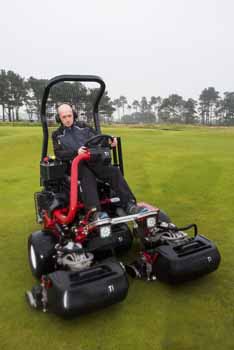
Pic Alan Richardson Dundee, Pix-AR.co.uk
Hi Sandy – what was your career path to this prestigious position?
Hello, I was brought up in the countryside just north of Blair Atholl in highland Perthshire; my father was a gamekeeper on Atholl Estates.
I played golf as a kid but went into greenkeeping aged 14 when the head greenkeeper at Pitlochry Golf Course, Donny McDonald, who was a family friend, asked if I would like to work on the golf course during the Easter holidays. For three years I worked the Easter and summer holidays there carrying out a variety of manual tasks: raking, switching dew, brushing greens and cleaning grass clippings with birch besoms, cleaning ditches and so on (I was too young to use machinery). I decided after completing the fifth year at secondary school that I would like to get into greenkeeping as a career rather than pursue what I always thought I would do in becoming a gamekeeper.
I attended Elmwood College in Cupar to do a one-year full-time NC in greenkeeping from age 16 which I thoroughly enjoyed. Part of the course was a communications module where we learned how to write letters properly and were advised to write prospective (hand written) letters to golf courses to look for work.
In March 1994 I wrote to around 30 golf courses in the north and east of Scotland as it was the part of the country I was most familiar with.
Fortunately, the course manager, Jim Grainger, at Letham Grange Golf Resort near Arbroath, got back to me and asked me over for a chat and thereafter offered me a position as an assistant greenkeeper which required me to finish up all my assessments three weeks early so that I could commence work at the start of June – the week prior to the Scottish Amateur Stroke Play Championship. I stayed in the staff quarters and remained there for three years prior to moving to Carnoustie Golf Links in May 1997. Letham Grange is where I met my wife, one of Jim’s daughters!
I managed to work my way up at Carnoustie (deputy of the Championship Course 2001 to 2003, head greenkeeper at Buddon Links 2003 to 2005, head greenkeeper of the Championship Course 2005 to 2012 and, finally, was fortunate to get the position of links superintendent in 2012 after the retirement of John Philp MBE. I’ve been at Carnoustie for 21 years.

What is the size of your team?
I have 35 staff in total (including me) split into three teams. This also includes four mechanics, an irrigation engineer and a maintenance technician. I take on 10 summer seasonals, three on full-time hours and seven on 20-hour weeks (a divot team and litter-man).
The key roles are three head greenkeepers: Craig Boath, Championship Course; Kevin Stott, Burnside Course; and Steve Mitchell, Buddon Links. Head mechanic, Sandy McCubbin; irrigation engineer, Angus McRae; greenkeeping administrator, Nicola Cunningham.
You mentioned John Philp MBE; what were the things that you learned from him that helped you in your career?
Sandy Reid: John is passionate for all things greenkeeping, golf and the Open, and always strived to make improvements and changes both to the agronomics and playability of the course, some of them massive, so having the opportunity to be part of all that was great. I like to think I put my best foot forward and worked hard.
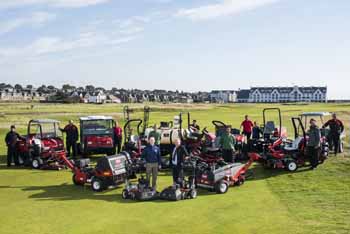
What would you say are the biggest challenges you currently face and how do these impact on you in your current role?
As the organisation grows, my time and knowledge are often required elsewhere other than on the golf courses which can make it difficult to find the structure in my day or week as well as I would like.
What drives you to achieve the high standards that you to deliver across the courses and what do you do to grow and develop your self and the standard to which you look to operate?
I take enjoyment and satisfaction from trying my best and doing a job well. I don’t look for thanks from anyone else.
With your love and understanding of the game of golf, how do you think that has helped you in your current job role?
I think it gives confidence to all my stakeholders knowing that I have a strong understanding of what the game of golf means to our hearts. I speak to golfers as most of them in my experience enjoy their visit to the course even more if they feel they are being looked after or have a bit of banter. Also, seeing and feeling the course through the eyes and mind of the golfer helps ensure that a few of the little things we can often miss during our working hours can be addressed.
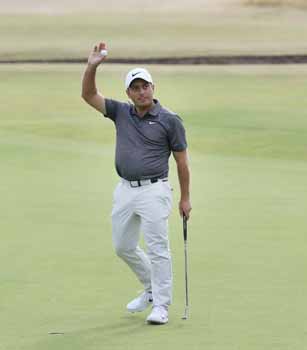
Every winter you undertake a serious amount of winter work at Carnoustie. Please can you give examples of the programmes run, the intensity to which they are executed and in what way the hard work pays off?
November is probably our busiest month of the year for work as that is when we commence our winter programme so we try to get as much done prior to Christmas as we can before the worst of the weather.
The winter work continues through until the end of March and it always seems a rush to get it finished. We are fortunate to also have a good number of tractors, trailers and diggers at Carnoustie to facilitate the big tasks we take on, such as raising fairways or creating spectator mounding. It is always satisfying to see the fruits of your labour after making physical changes and / or improvements to the courses.

You’ve said the further up the ladder you go, the further you can find yourself moving away from greenkeeping. How do you ensure you don’t lose touch with your roots and you keep close to the pulse of the courses?
It’s not that you get further away from greenkeeping, you just get further away from the specific reasons you got into it in the first place, such as working on machinery or walking the turf as often.
I think best and am at my most creative when out on the course so getting out to do something physically rewarding like a bit of fencing or pushing up the grass heap in the digger when I can I find time is very rewarding for the mind.
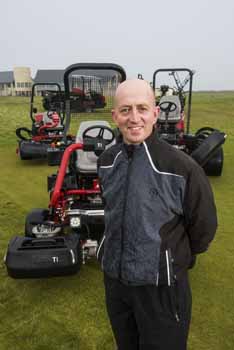
Pic Alan Richardson Dundee, Pix-AR.co.uk
Quality control is an important element of any high-end product. What do you do to ensure quality is maintained across the courses?
Regular chats with the head greenkeepers and a wee walk about at times but I find nothing is better for ensuring quality control than getting out for a game, something I’ve had less of the last couple of years.
What machinery fleet do you currently use, why is this your preference and what is it that impresses you most about it?
We use Toro equipment for all our cutting and spraying work and for most of our utility vehicles. The quality of build and reliability of Toro equipment is fantastic, as is the usability and comfort of it. Their commitment and focus on research and development ensures they produce quality machinery that the end user is asking for and appreciates using.
Due to the hot dry spell you experienced an unusual set of circumstances in the lead up to and during this year’s Open Championship, how did Toro help you through this and what did you experience?
With it being so hot in the run up to and during the Open, much of the grass was dormant or wasn’t growing particularly fast and didn’t need cutting as often as we would normally expect during ‘Championship week’, and it also meant that it was very susceptible to physical damage from wheels and so on. The whole Toro cutting fleet we had for the week did a fantastic job of producing fantastic surfaces with no damage but particularly the two 3555-D Fairway mowers Toro supplied as part of their ‘Tournament Support Fleet’ allowed us to keep the fairways tidy without subjecting the dry turf to any sort of scorching often caused by vehicle wheels during periods of drought stress.
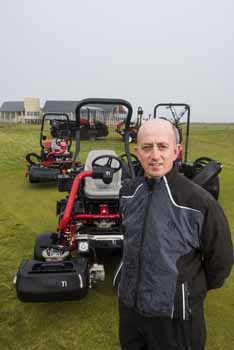
Pic Alan Richardson Dundee, Pix-AR.co.uk
How would you describe your style of management and why do you prefer to work this way?
Collaborative and consistent with a good attention for detail.
I was a head greenkeeper on the courses under John Philp for many years but even though he was a fantastic greenkeeper and had transformed Carnoustie, I wanted my own space to make decisions, so I try to give my head greenkeepers the space to make decisions themselves so long as the end results match expectations.
What height of cut do you use across the course and what man hours are spent mowing weekly?
Slight variations between the courses but in general: greens, between 4.2mm and 4.75mm; tees and surrounds, 6.5mm; fairways, 10mm; semi-roughs, 45mm.
Hours: The working week is 37.5 hours.
Training and education are key to developing a good team, what do you do to ensure you are investing in raising the standard of practice and performance from your greenkeeping team members?
We have a greenstaff training matrix that we review annually and try to fill in as many gaps as possible each year and have manged over the years to ensure we have a good training budget to help facilitate this.
I also try to encourage the senior staff to coach their staff on a variety of topics.
Who do you directly report to and how often do you meet, who else do you need to communicate with and how do you all work together for the benefit of the courses and business?
I report to the chief executive. Communication can vary from every day to once a fortnight, but we usually have a senior management team meeting once a week with the heads of department from the finance, pro shop, golf services, marketing and food and beverage teams all in attendance.

The pressures on the course manager to deliver a better product are growing year on year and the level of professionalism is rising with this. What do you think are the qualities now needed to meet the requirements and demands of golfers by someone in your position and how does this help contribute to the business of golf?
Love and understanding for the game of golf and a good knowledge of the expectations of your stakeholders.
What currently gives you the greatest satisfaction from your job, how do you feel daily when you are moving around the course looking at what you and the team have achieved and what do you feel are your biggest achievements to date?
Seeing a job well done. No achievements stand out but I have been fortunate to be involved in preparing the Championship course for 31 tournaments in my time here with the three Opens being the obvious highlights. This year’s especially, I suppose, given that I had more strategic input than in 2007 and 1999.
With your experience, what advice would you give to youngsters starting out and wanting to pursue a career in the profession today?
You need to understand the game and you need to be honest, especially with yourself. Ask yourself ‘can I do better?’ rather than just think you’re better than the person next to you.
In my experience most greenkeepers are all very similar in that the majority of us probably left school without great qualifications or without GCEs or highers. Like everyone used to tell me when I was a kid, ‘stick in at maths and English’, as it is still important in greenkeeping.
What changes do you think need to be made to benefit the industry sector and profession of the greenkeeper?
The understanding of the importance greenkeepers play is often underappreciated by the golfer, but I believe that for these people to have better appreciation and respect for the greenkeeper, the best way for us to achieve this ourselves is to just carry out our work honestly and to the best of our ability and not to go seeking praise.
If we do things to the best of our ability with sound and evidence-based reasoning behind our decisions, and communicate them appropriately, then golfers and relevant stakeholders are usually very understanding, respectful and appreciative.
I think we can also improve our professionalism and knowledge by getting out and visiting other golf courses and greenkeepers. We could also make better use of our mobile phones by using them to ring our peers for a chat more often rather than for moaning, or bragging, or posting pictures of routine work practices on social media.
All of us at GreenKeeping would like to congratulate you on your recent appointment to ‘Director of Greenkeeping’ at St Andrews. What are you most looking forward to in your new role?
Gordon Moir’s shoes are a big pair to fill so I just hope to play a small part in helping the ‘Home of Golf’ continue to improve and grow.

























